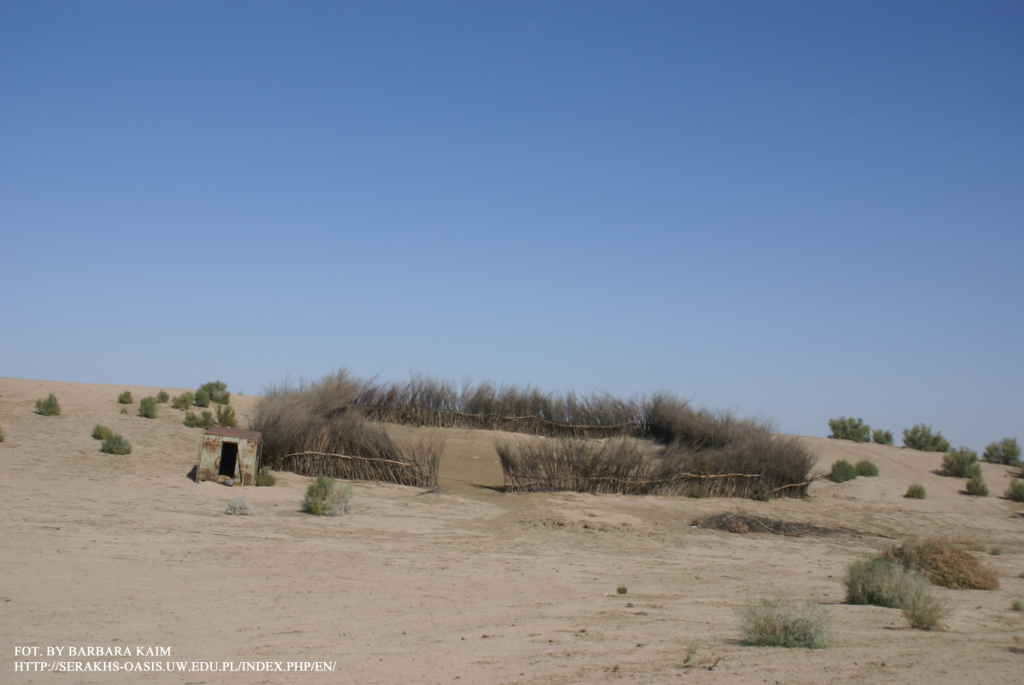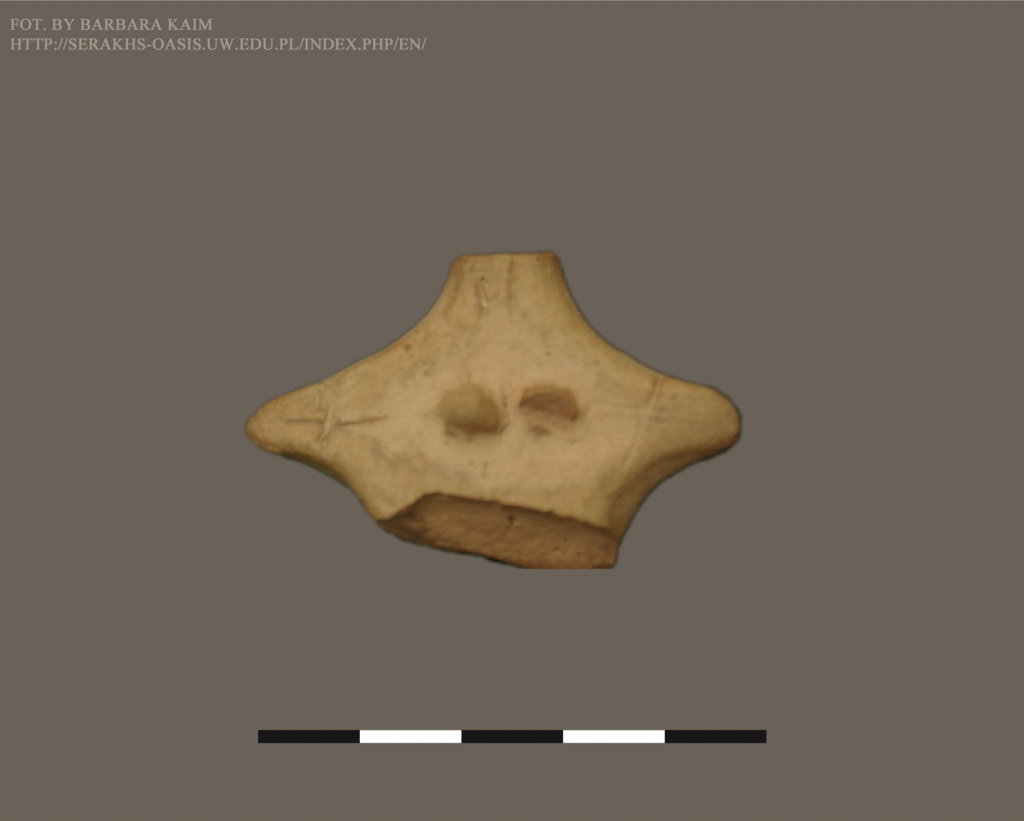
© B. Kaim
Berdysyčran-depe, a hitherto wholly unknown and inconspicuous site located in Turkmenistan in the ancient Tedjen River (Hari Rud) alluvial fan, turned out to have hidden remains of the Oxus civilisation.
Just two days after the publication of the results, the news about the discovery by Polish archaeologists was described by the N+1 portal. Soon it was quoted across various services popularising science and internet forums. That prompted us to write about this discovery on the Archeowieści portal.
For over twenty years, Polish archaeologists have been researching the Serakhs oasis on the Tedjen River, situated in Turkmenistan near the border with Iran and Afghanistan, as we explained in a previous article on the Archeowieści portal. The new discovery was made in the desert between the Serakhs oasis and the Tedjen River fan, located over 70 km to the north of the Serakhs oasis.

fig. N. Buławka
Oxus Civilisation
The Oxus Civilisation or the Bactria-Margiana Archaeological Complex (BMAC), was a rich archaeological culture occupying an area stretching from southern Turkmenistan and north-eastern Iran to southern Uzbekistan, south Tajikistan, northern Afghanistan and south-eastern Iran (Sistan). Moreover, the artefacts of the Oxus civilisation are found as far away as central Iran, the Indus Valley and Mesopotamia, which demonstrates the mutual trade contacts of these areas. The Oxus civilisation is famous for its monumental architecture discovered, for instance, at Gonur-depe. Research at a cemetery near the site revealed richly equipped graves containing gold, silver and stone vessels, stamp seals, alabaster miniature columns, jewellery and other luxury items made of rare imported raw materials.
The archaeological studies of Berdysyčran-depe
Berdysyčran-depe consists of two adjacent mounds. The southern one, covering an area of about 1 ha, is steep and 6 m high. The second one is higher (7 m) and bigger (2.1 ha). The area between these hills and their immediate vicinity is densely covered with pottery and other artefacts. The total size of the site is about 15 ha. The site is located in the desert, about 13 km east of the Tedjen River and about 60 km south of the modern city of Tedjen, situated on the alluvial fan of the river of the same name.
The surface research carried out in 2015 provided unexpected results. It turned out that the artefacts collected there, such as pottery, fragments of alabaster vessels and a piece of a terracotta figurine of a woman, date back to the Bronze Age.

© B. Kaim
The analysis of all the collected material allows the site to be dated to the Middle, Late and Final Bronze Age (2250-1500 BC), i.e. the time period corresponding to the rise, flourishing and fall of the Oxus civilisation. Berdysyčran-depe is, so far, the only site in the Tejden River alluvial fan linked to the Oxus civilisation, otherwise known as the Bactria-Margiana Archaeological Complex. The study of Berdysyčran-depe, supported by the analysis of CORONA satellite images and digital terrain models, allowed the reconstruction of the location of the Bronze Age arms of the Tedjen River. Their density suggests the possibility that this area was much more densely settled than the one discussed here.
The importance of the discovery
The discovery of Berdysyčran-depe changed our perspective on the development of settlement in the oases of the Tedjen River. It is also crucial for understanding the extent of the Oxus civilisation itself.
Scientists think that the origins of the Oxus civilisation should be linked with the local archaeological cultures of Central Asia. Such material is known in Turkmenistan from the excavations of Namazga-depe, Altyn-depe and the Geoksyur oasis, which was created and functioned thanks to irrigation canals linked to the Tedjen River.
The Geoksyur oasis was explored by a team of archaeologists and V. I. Sarianidi – later the discoverer of the famous Gonur-depe. Aerial photographs taken at the time made it possible to discover nine sites dated to the Chalcolithic period (4000-2700 BC). The largest of these, Geoksyur I, covered 12 ha and was 10 m high. Excavations at the Geoksyur sites revealed monumental architecture, distinctive painted ceramics and objects made of carnelian, chalcedony, lapis lazuli and turquoise. In addition, richly equipped graves were found nearby. Surveys carried out in the 1960s proved that towards the end of the Late Chalcolithic (3100-2700 BC), settlement began to decline in the Geoksyur oasis. Only one site is known to survive into the Middle Bronze Age, namely Khapuz-depe. Therefore, it was assumed that the oases of the Tedjen River were abandoned from the Middle Bronze Age (2250-1900 BC) until the beginning of the Iron Age (1500-300 BC). However, research by Polish archaeologists shows that the oases of the Tedjen River may have been inhabited longer than was previously thought.
First traces of the Oxus Civilisation in the Tedjen River oases
The remnants of the Oxus civilisation in the oases of the Tedjen River was first encountered in 1925 when a ceremonial copper axe was discovered near the Pul-i Hatun bridge. Another significant find was a miniature alabaster column found at the bottom of the Mele Hairam temple’s well (dated to the Parthian and Sassanian periods) and described by Marcin Wagner. Similar miniature alabaster columns were frequently found in graves linked to the Oxus civilisation, including Gonur-depe. Berdysyčran-depe is the first significant site of the Oxus civilisation found in the oases of the Tedjen River in Turkmenistan.

fig. N. Buławka
This article may be reprinted free of charge, without photos, with acknowledgement of the source.
About the Authors:
Nazarij Buławka – has a PhD in Archaeology, specialising in studying Iron Age settlements in Central Asia (from the second half of the 2nd millennium to the 4th century BC). His research uses geographic information systems techniques, including satellite image analysis, to study archaeological sites and ancient landscapes.
Maja Rzeplińska – is a graduate of the Faculty of Archaeology of the University of Warsaw (formerly the Institute of Archaeology). She is preparing her PhD thesis on terracotta figurines in Central Asia, Iran and Mesopotamia from the Hellenistic, Parthian and Sasanian periods.
Barbara Kaim – is the head of the Polish archaeological mission in the Serakhs oasis, and a professor at the University of Warsaw. She specialises in the archaeology, history and art of the Kushan, Parthian and Sasanian periods. She has directed, among others, archaeological projects at Mele Hairam fire temple (Turkmenistan), Gurukly-depe (Turkmenistan), Tang-e Bulaghi (Iran) and Khone-ye Div (Iran).
Editor: J.M.C.
Proofreading: Stephanie Aulsebrook
